Bulletin – March 1999 Australian Financial Markets
- Download 79KB
The Reserve Bank provides regular commentary on financial market developments in the Semi-Annual Statement on Monetary Policy and in the quarterly articles on The Economy and Financial Markets published in the Bulletin. This commentary focuses on linkages between the financial markets and the economy, mainly in relation to developments in financial market prices, that is interest rates and the exchange rate. The present note, on the other hand, looks beyond these short-term developments, and discusses the impact of recent structural change in financial markets in Australia.
To an important extent, the influences at work reflect changing economic conditions in Australia and abroad, but they also reflect a number of specific structural forces in the domestic financial system. The major structural forces include:
- the move from deficit to surplus in public-sector budgets;
- the programs of privatisation undertaken by the Commonwealth and State Governments and demutualisation of a number of financial institutions;
- innovation within the financial system, such as securitisation and the growth of funds under management; and
- the introduction of real-time gross settlement (RTGS) of high-value interbank payments, and consequent structural change in the payments system.
Fiscal consolidation and privatisations, for example, have seen markets for public-sector debt contract. At the same time, these factors have boosted private-sector issuance, both of debt and equity. Increased activity has also been apparent in the cash market, with the introduction of RTGS, and in the foreign exchange market. The latter is partly in response to activity in domestic markets, but also reflects heightened speculative activity in mid 1998. On the whole, Australian financial markets have grown solidly in recent years, adjusting smoothly to the substantial changes in the domestic and international environment.
This article summarises the main developments.
Domestic Financial Markets
Domestic securities markets, viewed broadly, are composed of markets for fixed-interest securities (or debt), cash and equities. The debt markets comprise the bond market – for long-term securities – and money markets – for short-term securities and cash. The markets for physical securities are augmented by derivative markets.
Statistics on the level of outstanding debt, and on turnover, in major markets in Australia are summarised in Table 1.
| Debt outstanding | Average daily turnover(a) | ||||
|---|---|---|---|---|---|
| December 1995 | December 1998 | 1994/95 | 1997/98 | ||
| Bond market(b) | |||||
| Commonwealth bonds(c) | 90 | 80 | 3.7 | 2.9 | |
| State Government bonds | 43 | 40 | 2.4 | 1.3 | |
| Corporate bonds | 10 | 20 | .. | 0.2 | |
| Asset-backed bonds | 7 | 19 | .. | 0.1 | |
| Money market | |||||
| Repurchase agreements | .. | .. | 6.0 | 12.3 | |
| Bank bills and CDs | 96 | 132 | 2.9 | 4.4 | |
| Promissory notes | 22 | 38 | 0.7 | 1.7 | |
| Treasury notes | 17 | 11 | 0.3 | 0.2 | |
| Memo item: | |||||
| Unsecured cash | .. | .. | .. | 9.7 | |
| Interest rate derivatives(d) | |||||
| Exchange-traded(e) | .. | .. | 27.7 | 37.0 | |
| Bills | .. | .. | 21.2 | 30.1 | |
| Bonds | .. | .. | 6.5 | 6.9 | |
| Over-the-counter | .. | .. | 6.4 | 4.0 | |
|
(a) Derived from 1998 Australian Financial Markets Report, Australian Financial
Markets Association. Source: Sydney Futures Exchange. |
|||||
Bond market
The impact of fiscal consolidation and proceeds from privatisation, which have been applied in large part to reducing debt, is clear in both the amount of public-sector bonds on issue and on market turnover. Commonwealth Government bonds on issue have fallen by $15 billion from their peak in 1996/97, to a level of $80 billion (Graph 1). Corresponding figures for State Government bonds show a fall of about $10 billion, to about $40 billion. Net public-sector debt in Australia is estimated at around 18 per cent of GDP, compared with a recent peak of 31 per cent in June 1994.
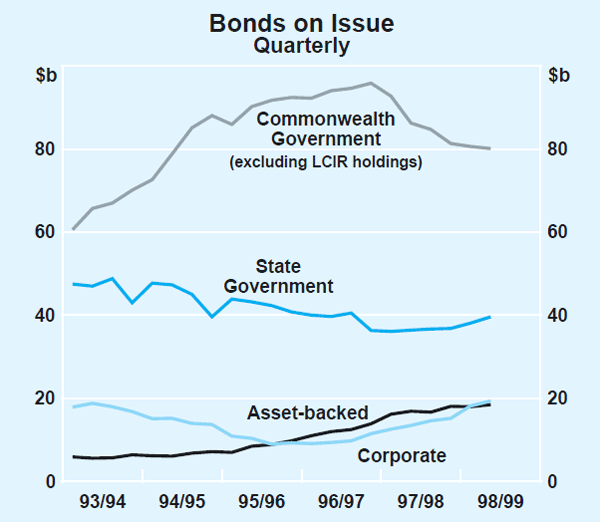
The trend to reduced issuance in primary markets has been associated with some reduction in trading activity, evident in lower turnover in bond markets (Graph 2). Some rationalisation of this sector, with a number of market makers in Government securities closing their dealing operations, has also reduced liquidity. The projected budget surpluses and the likelihood of further privatisations might see these trends run further.
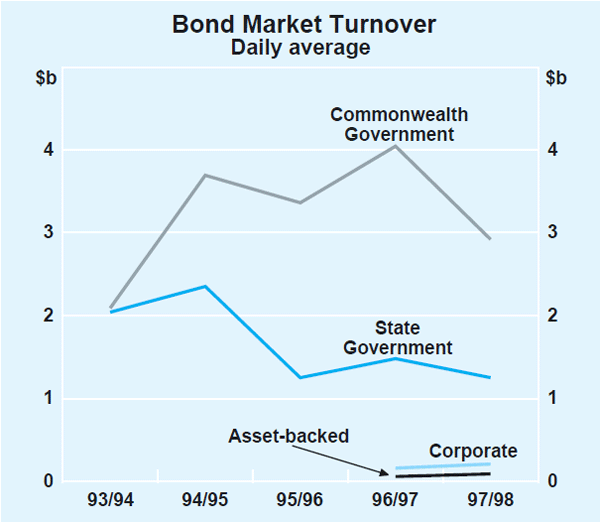
Although market rationalisation has worked to curtail trading activity, consolidation of government debt into a relatively small number of benchmark series has worked to enhance liquidity. In the case of Commonwealth Government Securities (CGS), these benchmark lines have been tailored to be eligible for inclusion in the basket of bonds used for pricing bond futures contracts in Australia. Futures trading is the main vehicle for trading and price discovery in the bond market (see below). Reasonable liquidity in the local market is reflected in the fact that spreads between buy and sell quotes on the secondary market are around 2 basis points on parcels of up to $50 million of stock (Graph 3). This spread is relatively narrow compared with bond markets elsewhere of similar size to that in Australia.
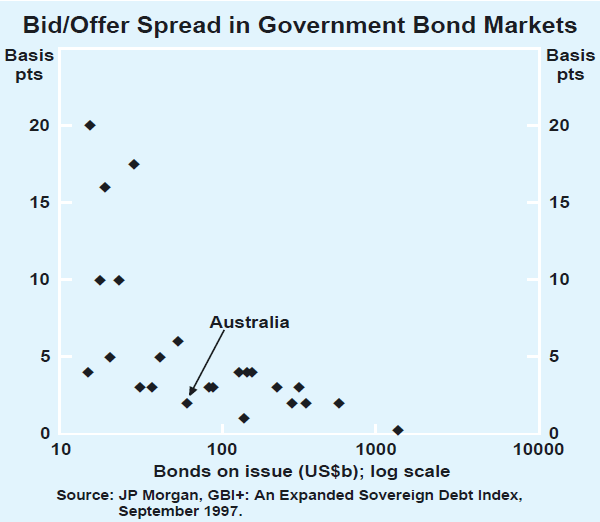
The Commonwealth Government has stated its intention to preserve a liquid bond market. This is partly to maintain a well-defined benchmark yield curve for private borrowers, since the pricing of private debt is likely to be more efficient and transparent if such debt is quoted at an interest margin, reflecting credit and liquidity considerations, above that of the sovereign issuer. As the most creditworthy issuer in the local currency, sovereign issuers provide an externality for the private sector in establishing a benchmark for pricing of debt of other issuers. This is an important consideration at a time when prospects seem promising for the development of private-sector bond markets in Australia.
By contrast with public-sector debt markets, private-sector issuance in Australia, in both the asset-backed and corporate bond markets, has increased rapidly in recent years. Growth in markets in asset-backed securities developed as mortgage managers and banks began to securitise loans, mainly residential mortgages. Banks' motivation for doing so is partly to free capital for more profitable uses. Asset-backed bonds on issue in Australia amount to about $19 billion, having doubled in the past two years. The corporate bond market in Australia has also expanded, following the prolonged period of weakness in the early 1990s, when companies focused on reducing gearing ratios from the unsustainable levels of the late 1980s. Best estimates suggest that outstandings in this market rose from about $10 billion in 1995 to about $20 billion at present. Issuers include banks, public trading enterprises, and small numbers of corporates and non-residents.
With corporate finances in healthy shape and prospects for business expansion promising, the outlook for private bond issues seems favourable. These positive supply conditions seem to be matched by an encouraging outlook on the demand side, with continuing strong growth in funds under management in Australia and with the public-sector market likely to continue to dwindle. Accordingly, there may be grounds for guarded optimism that private bond markets will grow further, with potential for turnover to rise from its current low rate.
Money market
Similar patterns are evident in markets for short-term securities. Strong government financial positions have resulted in short-term public-sector issuance receding, with outstandings of Commonwealth Government Treasury notes declining by around 15 per cent, on average, since 1995. By contrast, the level of privately issued money market securities – consisting of short-term debt instruments, mainly issued by banks – has continued to grow strongly (Graph 4). Within this category, the level of certificates of deposit (CDs) on issue has increased by about 75 per cent since 1995, to about $60 billion, a little below the level of bills outstanding, which has also recently resumed an upward trend. Bank bills outstandings had been declining since the late 1980s, the result of abolishing the Statutory Reserve Deposit (SRD) requirement on bank deposits; the SRD ratio had encouraged the issue of bank bills, to avoid the SRD cost associated with issuing negotiable CDs.
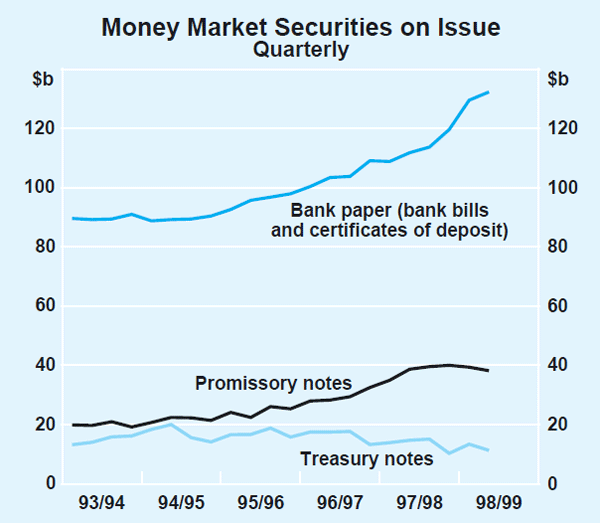
The main influence in the market for bank paper has been the healthy economic expansion in Australia since the early 1990s, resulting in robust growth of bank credit, with a counterpart rise in banks' liabilities. Greater reliance on liabilities issued as securities, as opposed to current or fixed deposits, gives banks greater discretion in managing their liabilities; such liabilities are also more attractive to certain classes of investors, such as funds managers, with a growing appetite for securities issued by institutions of high creditworthiness.
Short-term debt issued by corporations – promissory notes – has also increased strongly, by over 70 per cent since 1995, although growth tapered off in 1998, as this market was unsettled by instability in financial markets abroad. Growth in the market for corporate paper in Australia partly reflects, albeit somewhat belatedly, a global tendency for banks, and other financial intermediaries, to encourage corporations to approach securities markets directly. In this process, intermediaries can earn fee income, while avoiding the capital charge that would be incurred by lending funds directly to the corporate concerned. It is possible that some companies might also issue paper at finer spreads than would be available from bank finance, perhaps via swap markets.
The growth in issuance of private short-term securities has not translated into significantly higher turnover overall, although turnover for promissory notes has grown (Graph 5).
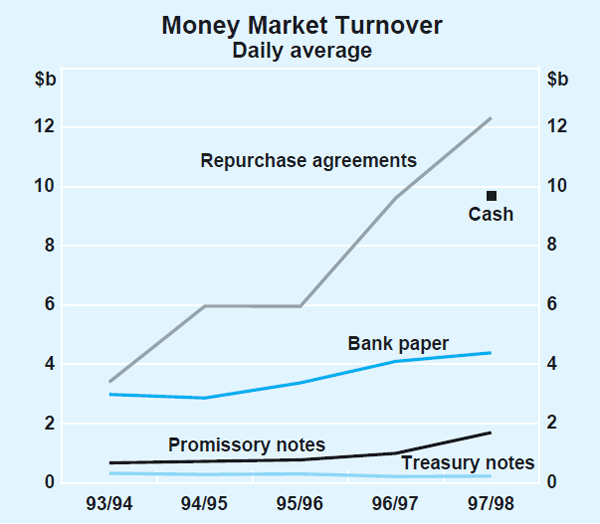
Cash market
Although not strictly speaking a securities market, activity in the cash market is intimately related to trading in securities markets since it is pivotal both to funding portfolio managers' securities positions and to banks' liquidity management operations.
Trading in cash may be either secured or unsecured, the former taking the form of repurchase agreements.[1] Repurchase agreements enable holders of securities to fund their securities positions by temporarily exchanging these securities for cash. The repo market also enables traders to operate on leverage.[2] The importance of the repo market is illustrated by the fact that turnover in repurchase agreements exceeds turnover in any of the underlying securities markets themselves, amounting to over $12 billion a day in 1997/98, double its rate of two years earlier.
Increased appetite for leverage may have been one factor in the expansion of the repo market in Australia, although extreme leveraging of positions in recent years seems to have been less evident in Australian markets than abroad, where hedge funds were active.
Another contributing factor may have been the Reserve Bank's decision in mid 1996 to widen the range of counterparties with which the Bank would be prepared to deal in its market operations, the bulk of which is in repurchase agreements. Until July 1996, the Reserve Bank had been prepared to deal only with a group known as the ‘authorised’ money market dealers. In preparation for the introduction of RTGS, it was decided that the Reserve Bank would be prepared to deal with all members of the Reserve Bank Information and Transfer System (RITS), the electronic system for settlement within the RTGS system. RITS has 240 members, including all major banks and financial institutions in Australia. As a result, the range of the Reserve Bank's counterparties in repurchase agreements increased noticeably. More generally, the phasing-in of RTGS has seen banks manage their liquidity more actively in recent years.
Most repos are undertaken for short periods, with government bonds the underlying instrument. According to the Australian Financial Markets Association (AFMA), in 1997/98 95 per cent of outstanding repos had a term to maturity of less than seven days, while 73 per cent of transactions involved CGS and 23 per cent State Government securities.
The unsecured cash market is essentially short-term borrowing and lending of claims on banks, and involves no trading of securities as such. It is, however, an important source of funding of positions held in securities markets, especially for institutions without suitable security to undertake repurchase agreements. Unsecured cash is more expensive than secured funds, with credit considerations playing a bigger role. Even so, the unsecured market is also active, with turnover in three unsecured cash instruments – 11 am, 24-hour call and term cash – estimated at $9.7 billion a day in 1997/98. These data were collated in 1998 for the first time by AFMA.
Derivatives market
Turnover in exchange-traded interest rate derivatives has grown at an annual average rate of about 20 per cent in the past two years, to around $37 billion a day in 1997/98 (Table 2). Growth in this market, which is conducted on the Sydney Futures Exchange (SFE), and its size relative to physical markets, partly reflects the fact that investors and traders typically establish positions in the futures market since transaction costs are lower than in the physical market. Strong growth in the futures market in recent years suggests that, so far, the decline in the physical bond market has not impeded trading in futures. While the futures market is active, the over-the-counter (OTC) derivatives markets remain small.
| 1993/94 | 1994/95 | 1995/96 | 1996/97 | 1997/98 | |
|---|---|---|---|---|---|
| Exchange-traded(a) | |||||
| Futures | 21.4 | 25.1 | 22.8 | 28.8 | 33.5 |
| Options | 2.0 | 2.6 | 3.0 | 4.9 | 3.5 |
| Total | 23.4 | 27.8 | 25.8 | 33.7 | 37.0 |
| Over-the-counter(b) | |||||
| Forwards | 3.2 | 4.9 | 2.9 | 2.1 | 2.0 |
| Swaps | 1.1 | 1.3 | 1.4 | 1.6 | 1.8 |
| Options | 0.3 | 0.2 | 0.2 | 0.3 | 0.2 |
| Total | 4.5 | 6.4 | 4.6 | 4.0 | 4.0 |
|
(a) Source: Sydney Futures Exchange. (b) Source: AFMA. Alternatively, BIS survey data show total OTC interest rate derivatives turnover averaged US$2.8 billion ($A3.8 billion) per day in April 1995 and US$2.8 billion ($A4.3 billion) per day in April 1998. |
|||||
Greater international interest seems to have been a factor in the recent acceleration of growth in trading in fixed-interest futures. Two strands were at work: first, confidence rose internationally that Australia's much improved inflation record in the 1990s would be sustained, with international investors positioning themselves to profit from likely falls in interest rates; second, as liquidity dried up in numerous overseas markets in 1997 and 1998, foreign investors took advantage of good liquidity in the Australian market, on occasion also viewing Australia as a proxy for investments elsewhere. In 1998, the Australian market for exchange-traded interest rate derivatives was the seventh most heavily traded in the world.
The Equity Market
Market capitalisation and turnover
Privatisation, which worked against activity in the public-sector bond market in recent years, gave impetus to the equity market, which has grown strongly, both in terms of market capitalisation and turnover. Privatisations and demutualisations have seen major new listings of companies and spread share ownership more widely in Australia. These developments occurred against the backdrop of the favourable global climate for equities.
Market capitalisation of listed domestic companies has increased by two-thirds since the middle of the decade, to about $540 billion at end December 1998. In the same period, turnover on the Australian Stock Exchange (ASX) almost doubled, to an average of $1.0 billion a day in 1998 (Graph 6). A common measure of market liquidity – turnover relative to capitalisation – has also increased solidly, from a ratio of about 40 in the mid 1990s to 55 in 1998.
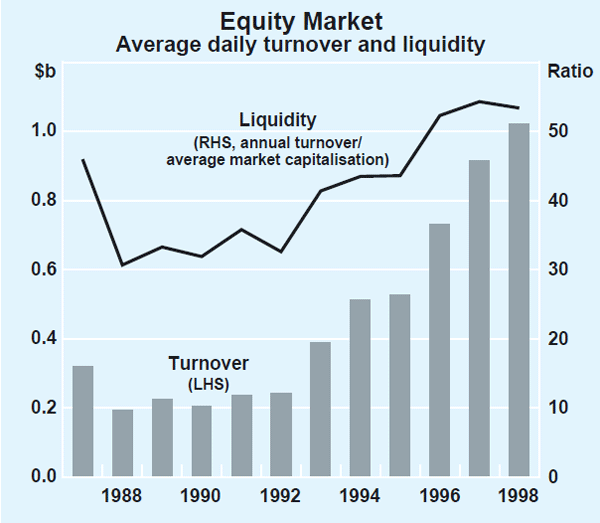
The direct effect on market capitalisation of newly listed privatised and demutualised companies has been significant. Net assets of this group at the time of their listing amounted to almost $50 billion, but was estimated at $110 billion in December 1998 as a result of appreciation in the price of the stocks concerned.[3] Trading in these shares has also contributed to the rise in market turnover. This was most pronounced in the days shortly after listing of new companies, as individuals – the main subscribers – took profit while institutions looked to buy stock into portfolios to replicate standard investment indices.
An index of share prices of privatised and demutualised companies, calculated by the Reserve Bank, is shown on Graph 7. This index has grown much more quickly than the market-wide indicator of share prices, the All Ordinaries Index. Since 1995, the index of share prices of privatised and demutualised companies has increased by a factor of about three, while the All Ordinaries has increased by about half this. A reason for this divergence is that the All Ordinaries has been restrained by falls in share prices of resource companies. Privatised and demutualised companies generally operate in sectors in which share prices have risen strongly. For a number of technical reasons, it is difficult to make precise comparisons between the index of privatised and demutualised companies and a ‘peer’ group of companies, although it seems possible that the former would, on average, have grown a little more quickly than the latter. (Among other measurement problems, the index of privatised and demutualised companies does not capture the impact of ‘stag’ profits, i.e. gains made as the difference between the listing price and the value of a share at the end of its first day's trading.)
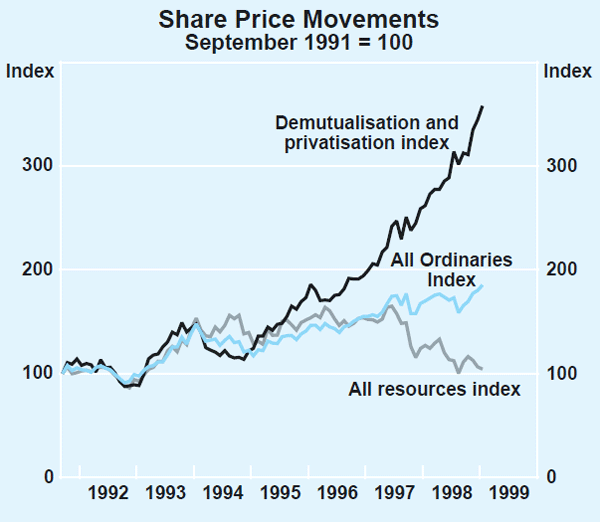
A further effect of privatisation and demutualisation is that ownership of shares by individuals in Australia has become noticeably more widespread (Graph 8). According to the ASX, 40 per cent of adults in Australia had investments, either directly or indirectly, in the share market in October 1998, almost double the level at the beginning of the decade. About 32 per cent of adults have direct holdings of shares, compared with a little over 10 per cent in the early 1990s. While comparisons across countries are difficult, it would appear that share ownership in Australia is now more highly dispersed than in the UK and Canada, but less so than in the United States.
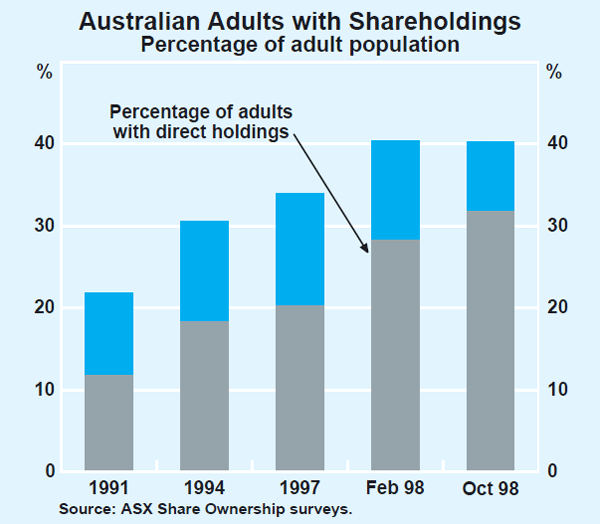
Globally, the ASX is middle-ranking on most measures of stock market size, at around thirteenth in terms of both turnover and market capitalisation (Table 3).
| Annual turnover $A billion |
Market capitalisation(b) | Liquidity ratio(c) |
Number of listed domestic companies |
||
|---|---|---|---|---|---|
| $A billion | Per cent of GDP | ||||
| United States(d) | 10,389 | 16,739 | 152 | 62 | 8,430 |
| Taiwan | 1,749 | 442 | 116 | 396 | 404 |
| Germany | 1,293 | 1,273 | 45 | 102 | 700 |
| United Kingdom | 1,129 | 3,176 | 187 | 36 | 2,465 |
| Japan(e) | 1,071 | 3,268 | 58 | 33 | 1,805 |
| Switzerland | 639 | 884 | 258 | 72 | 216 |
| Hong Kong | 635 | 636 | 273 | 100 | 638 |
| Spain(f) | 535 | 360 | 49 | 149 | 385 |
| France | 515 | 1,043 | 56 | 49 | 744 |
| Canada(g) | 401 | 909 | 109 | 44 | 1,362 |
| Netherlands | 358 | 849 | 175 | 42 | 357 |
| Italy | 251 | 531 | 34 | 47 | 235 |
| Australia | 231 | 454 | 86 | 51 | 1,159 |
| Sweden | 199 | 407 | 133 | 49 | 245 |
| Korea | 126 | 65 | 11 | 194 | 776 |
| Norway | 58 | 103 | 50 | 57 | 196 |
| Denmark | 57 | 143 | 63 | 40 | 237 |
| Finland | 45 | 112 | 70 | 40 | 116 |
| Singapore | 44 | 164 | 126 | 27 | 303 |
| Belgium | 37 | 210 | 64 | 18 | 141 |
| Greece | 27 | 53 | 31 | 50 | 227 |
| Austria | 16 | 56 | 20 | 28 | 101 |
|
(a) Sources: Fact Book 1998, London Stock Exchange; Fact Book 1998,
Taiwan Stock Exchange. (b) As at end December 1997. (c) Ratio of annual turnover to market capitalisation. (d) New York, NASDAQ and American exchanges. (e) Tokyo exchange. (f) Madrid exchange. (g) Toronto exchange. |
|||||
Increasing international integration of the Australian share market is evident in several respects: 60 overseas-based companies are listed on the ASX, with a total capitalisation of $340 billion, compared with 36 companies with capitalisation of $53 billion a decade earlier; foreign investors account for about 20 per cent of trading on the ASX, while they own about 30 per cent of shares listed on the ASX.
As in the bond market, trading in equities is augmented by an active market in derivatives, with the SFE and ASX Derivatives (ASXD), a subsidiary of the ASX, offering contracts. The main instrument traded on the SFE is futures and options contracts on the Share Price Index (SPI), which is based on the All Ordinaries Index, as well as contracts in individual equities. Trading in equity-based contracts averaged $1.2 billion per day in 1998, broadly equivalent to turnover in the physical market. The notional value of equity option turnover on the ASXD was about $0.3 billion a day in 1998, or around one-third of turnover in the physical market. Turnover in equity options on the ASXD consistently places this exchange in the world's top 10 equity derivatives exchanges.
The Foreign Exchange Market
The rise in turnover in domestic financial markets has been accompanied by rising turnover in the foreign exchange market, where the impact of the episodes of global market turbulence in recent years has been marked. An effect peculiar to Australia among global markets was that, as liquidity dried up in foreign exchange markets in a number of emerging countries, speculators took positions in the much more liquid Australian market to hedge positions that could not be liquidated elsewhere. At different times, Australia was viewed as a proxy for Asian markets and markets of other commodity exporting countries, such as Russia or Latin American countries, in which normal market activity had broken down. This added both to exchange rate volatility and foreign exchange market turnover, especially in the Australian dollar.
The Australian market
The extent to which the Australian dollar was caught up in the international volatility of recent years is evident in the rise in turnover and the pattern of trading in the Australian market. Over the past three years, aggregate turnover in the Australian foreign exchange market grew by 60 per cent, measured in Australian dollars, to an average of $82 billion a day in the second half of 1998. By contrast with earlier periods in the 1990s, strong growth was registered both in trading in the Australian dollar and in other (or ‘third’) currencies. In recent years, turnover in the Australian dollar has exceeded that of turnover in other currencies in Australia, reversing the pattern seen over much of the 1990s (Graph 9). The rising prominence of Asian developments was also reflected in the pattern of trading in other currencies, with the US dollar/yen currency pairing becoming the next most heavily traded exchange rate in the Australian market after the $A/US dollar pairing (Table 4). The share of transactions in the US dollar/German mark fell dramatically, a trend also evident in other markets as Stage III of European Monetary Union approached.
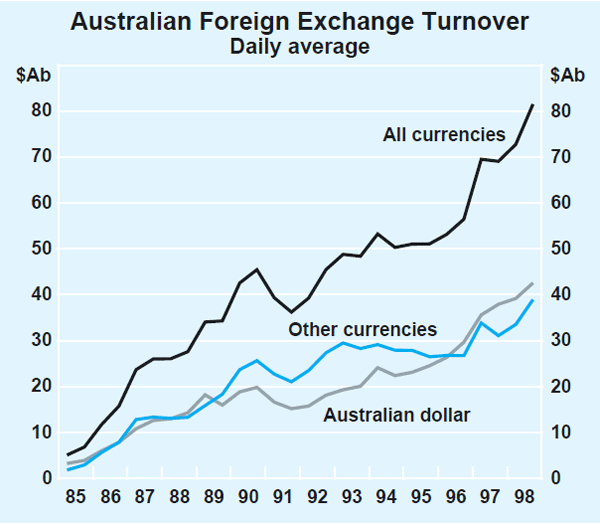
| Currency pair | April 1995 | April 1998 |
|---|---|---|
| AUD/USD | 42.0 | 53.9 |
| USD/JPY | 13.3 | 14.3 |
| USD/DEM | 21.7 | 12.3 |
| NZD/USD | 3.2 | 5.8 |
| GBP/USD | 7.0 | 4.6 |
| USD/CHF | 2.6 | 0.8 |
|
(a) Gross turnover (i.e. not adjusted for local dealer double counting) in spot, outright forward and FX swap transactions. Source: ‘Survey of Foreign Exchange and OTC Derivatives Turnover’, Reserve Bank of Australia Media Release, 29 September 1998. |
||
The rise in turnover in Australian markets was heavily concentrated in spot transactions, consistent with greater position-taking in the market and speculative activity (Graph 10). In the normal course, spot and swap transactions are closely associated since swaps are commonly used to alter the value date of spot deals, thereby helping manage banks' liquidity.[4] Other factors, unrelated to foreign exchange trading, such as banks' domestic liquidity management, have also increased the depth and liquidity of the Australian dollar swap market over the course of the 1990s. This meant that turnover in swap transactions exceeded spot transactions for most of the 1990s. The surge in spot turnover in 1998, however, has seen spot market turnover move to a level not far short of that in the swap market in recent months.
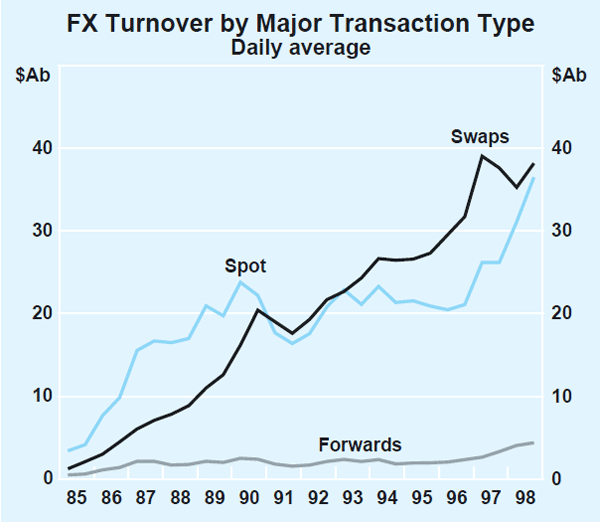
While outright forward transactions remain a small part of total turnover, they have doubled in size over the past two years. Turnover of over-the-counter options and cross-currency interest rate swaps has also grown strongly since 1995, although these instruments continue to account for a small portion of the overall market.
As a predominantly wholesale market, the majority of foreign exchange turnover is ‘inter-dealer’ – that is, dealers transacting currencies with other dealers either in Australia or offshore. In the December quarter of 1998, inter-dealer transactions accounted for about 85 per cent of turnover in the Australian market, of which roughly two-thirds were conducted with overseas dealers (Table 5).
| Dec qtr 1995 |
Dec qtr 1998 |
|
|---|---|---|
| By transaction type | ||
| Spot | 18.6 | 32.6 |
| Outright forwards | 1.9 | 4.4 |
| Swaps | 27.2 | 36.6 |
| OTC options | 0.7 | 2.4 |
| Total | 48.5 | 75.9 |
| of which: against AUD | 24.6 | 41.8 |
| By counterparty(b) | ||
| With customers | .. | 12.5 |
| With other resident dealers | .. | 23.6 |
| With overseas banks | .. | 39.9 |
| Total | 48.5 | 75.9 |
|
(a) Adjusted for local dealer double counting. Excludes cross-currency interest rate
swaps, turnover for which was estimated at $0.6 billion per day in April
1998. (b) Comparable data for December 1995 are not available. |
||
Around one-quarter of trading in the Australian market is undertaken through brokers. This proportion increased noticeably in the second half of 1998, suggesting some greater wariness among market makers to quote two-way prices. This caution may be a result of the exchange rate volatility, reflecting activity of hedge funds in mid and late 1998, which exposed traders to greater potential for loss.
Notwithstanding the rise in foreign exchange turnover in recent years, there has been a degree of rationalisation in the market, with the number of participants falling, from 76 authorised dealers in 1995, to 63 currently. The market has become more highly concentrated, with the top 10 largest dealers now accounting for around 80 per cent of market turnover, compared with 70 per cent in 1995. The reduced participation in the market reflects both mergers between dealers, and departures from the market, which have been most apparent among Japanese institutions.
The global context
The rise in turnover in the Australian foreign exchange market since 1995 – when the previous global foreign exchange survey was conducted – was 18 per cent (measured in US dollars), below the growth in global turnover of 25 per cent. The Australian market has, however, grown more quickly than some others in the region, including Japan and Hong Kong. On these figures, the Australian foreign exchange market is still ranked ninth in the world by turnover. In April 1998, the global foreign exchange market was dominated by London, which accounted for one-third of all trading, nearly double the size of the second largest market, the United States (Table 6). Both of these markets expanded by around 40 per cent between 1995 and 1998.
| US$ billion | Market share Per cent | Per cent change since April 1995 |
|
|---|---|---|---|
| United Kingdom | 637 | 32.3 | 37 |
| United States | 351 | 17.8 | 44 |
| Japan | 149 | 7.5 | −8 |
| Singapore | 139 | 7.1 | 32 |
| Germany | 94 | 4.8 | 24 |
| Switzerland | 82 | 4.1 | −6 |
| Hong Kong | 79 | 4.0 | −13 |
| France | 72 | 3.6 | 24 |
| Australia | 47 | 2.4 | 18 |
| Netherlands | 41 | 2.1 | 61 |
| Other | 280 | 14.3 | 27 |
| Total turnover | 1,971 | 100.0 | 25 |
|
(a) Turnover in spot, outright forward and FX swap transactions adjusted for local dealer double counting. Source: ‘Central Bank Survey of Foreign Exchange and Derivatives Market Activity in April 1998: Preliminary Global Data’, Bank for International Settlements Press Release, October 1998. |
|||
Also in April 1998, the Australian dollar was the world's eighth most heavily traded currency. Globally, turnover in the Australian dollar rose by 46 per cent, almost double the global growth in turnover. Around 60 per cent of Australian dollar trading occurs outside the Australian market.
The US dollar remains the most heavily traded currency, and is involved in 87 per cent of transactions (Table 7). This represents a rise of 4 percentage points since the previous survey, reflecting the effect of a stronger US dollar over the period. Expressed at constant exchange rates, the share of US dollar transactions fell between 1995 and 1998, while yen transactions picked up. Trading in the German mark and the French franc declined significantly as the scope for currency plays between European countries declined as EMU approached.
| April 1995 | April 1998 | |
|---|---|---|
| US dollar | 83 | 87 |
| German mark | 37 | 30 |
| Japanese yen | 24 | 21 |
| Pound sterling | 10 | 11 |
| Swiss franc | 7 | 7 |
| French franc | 8 | 5 |
| Canadian dollar | 3 | 4 |
| Australian dollar | 3 | 3 |
| ECU and other EMS currencies |
15 | 17 |
| Other currencies | 10 | 15 |
| Total | 200 | 200 |
|
(a) Refers to the use of the currency as one side of a transaction; figures are adjusted for both local and cross-border double counting. Includes spot, forward and FX swap transactions. Source: See Table 6. |
||
Footnotes
In a repurchase (repo) agreement securities are exchanged for cash with an agreement to reverse the transaction at a future date at an agreed price. The term of the repo is determined by the parties entering the transaction. Securities of any maturity can be used as collateral in the transaction. [1]
See ‘The Use of Leverage in Financial Markets’, Box B, Semi-Annual Statement on Monetary Policy, November 1998. [2]
See ‘Privatisation in Australia’, Reserve Bank of Australia Bulletin, December 1997 and ‘ Demutualisation in Australia’, Reserve Bank of Australia Bulletin, January 1999. [3]
A foreign exchange swap involves the exchange of two currencies with an agreement to reverse the transaction on a specified date at a specified exchange rate. A foreign exchange swap has a similar effect on a bank's liquidity flows as a repurchase agreement in the domestic market. [4]